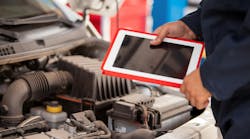Tire Pressure Monitoring Systems (TPMS) are standard on any vehicle made after 2007, but have existed as far back as 1985, and can be present on some of those older models. Technology, however, continues to evolve, and shop technicians will need to keep up on how to handle TPMS and use the monitors to aid in servicing vehicles.
The Basics
TPMS is an electric system alert with a warning indicator located on the dashboard that notifies the driver that a tire is low on air and therefore that the vehicle may be hazardous to drive. Some modern cars can actually alert drivers to the specific tire and even the actual tire pressure, while other monitoring systems just signal that one of the tires is low and needs air.
While the detailed information is useful, even basic TPMS can provide additional information that can help determine the amount of air in the tire, or whether the sensor is malfunctioning.
“A solid TPMS light indicates that one tire (or more) is underinflated by 25% (or more) under the recommended pressure,” explains Yanick Leduc, global technical training manager at Schrader TPMS.
“A flashing TPMS light indicates that one of the sensors (or more) is not communicating properly with the vehicle,” Leduc tells NOLN.
Technicians are advised to pay attention to the sensor light to verify what the warning actually means. Sometimes that involves starting the car a few times.
“The flashing TPMS light will flash only for 60-to-90 seconds, then remain solid,” Leduc details. This is a way to avoid confusion between the two warning light systems. “Technicians should make sure to look at the TPMS light on the dashboard after a full ignition key cycle.”
Two TPMS Technologies
In vehicles, there are either direct or indirect TPMS systems. The former receives tire pressure data from the tire valve through dedicated sensors, though sometimes the sensors are wireless and may have components embedded in the tire. An indirect system is built into the ABS system and provides an approximate reading of tire pressure.
“The indirect TPMS system uses the ABS system and determines the pressure based on the rotation speed of each wheel,” Leduc says. “As a tire loses air pressure, the overall diameter of the wheel is reduced and therefore the wheel will be rotating faster.”
While an indirect system analyzes the data to alert drivers when an underinflated tire is unsafe for driving, a direct TPMS system uses the actual tire pressure determined from the valve-based sensor to alert when tire pressure and temperature of the air inside the tire reach dangerous levels.
Where the Rubber Meets the Sensor
TPMS might be useful for diagnosing a problem when a car comes into the shop, though technicians need to address tires with care to keep those systems operational.
“It is important to keep in mind that tires are not just rubber anymore,” states Leduc. “There is technology inside and it requires special attention when it comes to the tire mounting and dismounting process.”
This process requires specialized training on “how to position the valve when breaking the bead, and how to position the rim, when mounting and dismounting the tire,” instructs Leduc.
TPMS communicate through radio frequencies as direct systems are typically attached to the tire’s valve.
“TPMS sensors are one of the very few systems that communicate through radio frequency,” Leduc says. “So, the importance of a strong training program and the acquisition of a reliable TPMS diagnostic tool is key to becoming a successful TPMS professional.”
Each time a tire is serviced, the TPMS should be part of that practice.
“The tire industry association (TIA) recommends to service all the wearable components of the valve every time the tire is removed from the rim,” explains Leduc.
When a TPMS fails, replacement kits are available. Leduc does warn that some cars require specific kits.
“TPMS service packs are readily available on the market, as are replacement sensors,” he says. “But these are specific to certain make, model and year of vehicle, so care needs to be taken on selecting the correct pack or sensor.”
Aftermarket TPMS
A shop might not often see an off-road vehicle or classic car, but these are the customers who need to add a device in order to monitor tire pressure.
"For vehicles not initially equipped with a TPMS system, there are retrofit kits available that can be installed quite easily," says Leduc. "It consists of valve-mounted TPMS sensors that can be installed by any shop with a tire machine."
The kit also includes an external display to mount to the dashboard that connects to power through a cable, and solar models are available.
"These kits are very popular for off-road enthusiasts who like to lower the pressure for additional grip and still be able to monitor the pressure of the tires," Leduc explains. "And for 'antique' and 'classic' car owners, who wish to maximize tire life."





